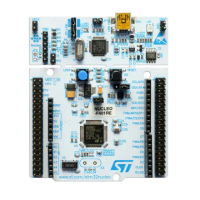RM0401 Rev 3 145/771
RM0401 General-purpose I/Os (GPIO)
154
6.3.13 Using the OSC32_IN/OSC32_OUT pins as GPIO PC14/PC15
port pins
The LSE oscillator pins OSC32_IN and OSC32_OUT can be used as general-purpose
PC14 and PC15 I/Os, respectively, when the LSE oscillator is off. The PC14 and PC15 I/Os
are only configured as LSE oscillator pins OSC32_IN and OSC32_OUT when the LSE
oscillator is ON. This is done by setting the LSEON bit in the RCC_BDCR register. The LSE
has priority over the GPIO function.
Note: The PC14/PC15 GPIO functionality is lost when the 1.2 V domain is powered off (by the
device entering the standby mode) or when the backup domain is supplied by V
BAT
(V
DD
no
more supplied). In this case the I/Os are set in analog input mode.
6.3.14 Using the OSC_IN/OSC_OUT pins as GPIO PH0/PH1 port pins
The HSE oscillator pins OSC_IN/OSC_OUT can be used as general-purpose PH0/PH1
I/Os, respectively, when the HSE oscillator is OFF. (after reset, the HSE oscillator is off). The
PH0/PH1 I/Os are only configured as OSC_IN/OSC_OUT HSE oscillator pins when the
HSE oscillator is ON. This is done by setting the HSEON bit in the RCC_CR register. The
HSE has priority over the GPIO function.
6.3.15 Selection of RTC additional functions
The devices feature one GPIO pin, RTC_AF1 (PC13), that can be used for the detection to
a tamper event, a time stamp event, an RTC_ALARM or an RTC_CALIB:
• RTC_ALARM output: this output can be RTC Alarm A, RTC Alarm B or RTC Wakeup
depending on the value of OSEL[1:0] bits in the RTC_CR register
• RTC_CALIB output: this feature is enabled by setting the COE[23] in the RTC_CR
register
• RTC_TAMP1: tamper event detection
• RTC_TS: time stamp event detection
The selection of the corresponding pin is performed through the RTC_TAFCR register as
follows:
• TAMP1INSEL is used to select which pin is used as the RTC_TAMP1 tamper input
• TSINSEL is used to select which pin is used as the RTC_TS time stamp input
• ALARMOUTTYPE is used to select whether the RTC_ALARM is output in push-pull or
open-drain mode
The output mechanism follows the priority order listed in Table 26.
Table 26. RTC additional functions
(1)
Pin
configuration
and function
RTC_ALARM
enabled
RTC_CALIB
enabled
Tamper
enabled
Time
stamp
enabled
TAMP1INSEL
TAMPER1
pin selection
TSINSEL
TIMESTAMP
pin
selection
ALARMOUTTYPE
RTC_ALARM
configuration
Alarm out
output OD
1Don’t care
Don’t
care
Don’t
care
Don’t care Don’t care 0
Alarm out
output PP
1Don’t care
Don’t
care
Don’t
care
Don’t care Don’t care 1

